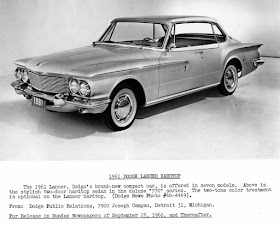The last production designs created under Exner's direction were 1962 Dodge Darts and Polaras and '62 Plymouth Furys. They did not do well in the marketplace and were quickly facelifted by Exner's successor, Elwood Engel.
Those Dodges and Plymouths were smaller than previous versions, which was not helpful in a market where competitive brands were larger. Another problem was their styling differed from what potential buyers seemed to prefer. Various sources refer to a statement by Exner that the new designs were like "plucked chickens" -- a presumed reference to the absence of the tail fins he had championed.
I find it difficult to characterize Exner's own work and designs created under his responsibility. Almost everything he did had its quirks. Some designs have held up very well: 1947 Studebaker, 1951 Chrysler K-310 show car, 1953 DeSoto Adventurer show car, 1955 Chrysler 300 and DeSoto, and the entire 1957 Chrysler Corporation line. Many others have not.
Today's post focuses on those 1962 Dodges and Plymouths and their styling studio context.
Chrysler styling studio, 1959
The full-scale models are proposals for the 1962 model year.
Chrysler styling studio, 1959
Looking across the other side of the room. The Plymouth model is at the right side of both images.
Proposed 1962 Imperial
Brand identification items include the grille, semi-detached headlights and the gunsight tail lights. The raised sculpting above the wheel openings was a feature Exner placed on all these proposals.
Proposed 1962 Imperial
Note the contrast between the side sculpting and the curved sides that include the window glass. I think this design is better than that of 1961 model year Imperials.
Proposed 1962 DeSoto Adventurer
The DeSoto brand was axed late in 1960 after a few 1961 models had been built, so this design would never have seen production. Again, there is raised side sculpting, though the rear element is more complex (I've read that stylists called it a "chicken wing"). The front end should have had a better design. Even replacing the outer headlight's chrome with body color paint would have improved matters some.
Proposed 1962 DeSoto Adventurer
These Exner designs featured a flat extension of side sculpting that wrapped across the trunk. Conceptually, not a bad thing.
Proposed 1962 Plymouth
Chrysler's entry-level brand would have looked nice from this angle if the grille was better done. As can be seen farther down, a more attractive version of this grille concept entered production.
Proposed 1962 Plymouth
Rear quarter view of the same model. This side presents an alternative passenger compartment greenhouse treatment that I think is less satisfactory than the one shown above. The brightwork wrapping from the rear wheel openings across the aft end of the car contrasts too much from what otherwise is a nice, simple design.
1960 Plymouth Valiant
The Exner side treatment seen on the 1962 model year styling prototypes pictured above reached production for 1960 on the new compact Plymouth Valiant. That means Exner was thinking of those features perhaps as early as 1957.
1961 Dodge Lancer press release
The Dodge version of the Valiant arrived for the 1961 model year.
1962 Dodge Dart
1962 Dodge Darts and Polaras received the same sort of side sculpting as the Valiants and Lancers.
1962 Dodge Polara - Barrett-Jackson auction photo
Exner liked long hoods. So do I.
1962 Dodge Polara - Barrett-Jackson
The rear end design is too fussy for my taste.
1962 Plymouth Fury - Barrett-Jackson
The side sculpting on production '62 Plymouths is similar to that seen on the 1959 styling model pictured above. But different from the '60 Plymouth Valiant sculpting that wound up on those 1962 Dodges.
1962 Plymouth Fury - Barrett-Jackson
Production tops were less-curved that those of the styling model.
1962 Plymouth Fury - Barrett-Jackson
Fortunately, the production rear design was an improvement over that seen on the model. Although 1962 Plymouths looked odd when they first appeared, in retrospect the design is pretty good. And curved side window glass would have made it even better.
















I recently read the article on Ate Up With Motor about the debacle that brought about the "plucked chickens" of '62, incredibly fascinating! Looking at the styling mock-ups, in hind-sight, the Mopars would still have looked rather melodramatic compared to the competition and would have, as you said, been just as polarising. I do enjoy seeing what could have been compared to what was eventually released.
ReplyDeleteI think the proposed Plymouth looks great. That photo really helps one understand why Exner was so upset at the ill-fated downsizing. He had a good-looking mainstream car to offer. The DeSoto appeals to me as well, as it's relatively similar in form to the Plymouth. The Imperial, not so much. Looks boxy and ungainly.
ReplyDelete